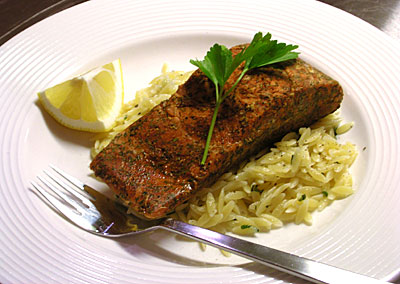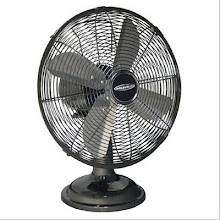 OK, the salmon itself doesn't suck but there is a little sucky-sucky that went into making this salmon dish. I made this with a method developed in France about 30 years ago called sous vide that is now becoming popular in some of the high end restaurants in the United States. Chef Thomas Keller is using it quite bit at French Laundry in Napa Valley and Per Se in Manhattan, and if it's good enough for Thomas Keller, it's definitely good enough for ol' Jimbo. Cooking sous vide involves vacuum sealing fish and meat then cooking it in water baths at low temperatures, typically between 140 to 160 degrees F. The benefit is that most of the cellular walls maintain their integrity. They don't burst and release their juices, which happens under high heat. Foods cooked sous vide is supposed to be more moist than those cooked in conventional pans and ovens.
OK, the salmon itself doesn't suck but there is a little sucky-sucky that went into making this salmon dish. I made this with a method developed in France about 30 years ago called sous vide that is now becoming popular in some of the high end restaurants in the United States. Chef Thomas Keller is using it quite bit at French Laundry in Napa Valley and Per Se in Manhattan, and if it's good enough for Thomas Keller, it's definitely good enough for ol' Jimbo. Cooking sous vide involves vacuum sealing fish and meat then cooking it in water baths at low temperatures, typically between 140 to 160 degrees F. The benefit is that most of the cellular walls maintain their integrity. They don't burst and release their juices, which happens under high heat. Foods cooked sous vide is supposed to be more moist than those cooked in conventional pans and ovens.In a restaurant the technique requires industrial vacuum sealers and large precise-temperature-controlled water baths. I don't have this kind of equipment at home but I still wanted to see if I could apply some of the technique with equipment I already have. Besides, I don't have the kind of cash flow that allows me to eat at French Laundry and Per Se. (Translation: I'm a cheap bastard.)
Amazingly, my cheap ass had sprung for a Tilia FoodSaver vacuum sealer a couple of years ago. Actually it's really not that amazing since the reason why I got it was because I was sick and tired of throwing away good leftovers that had spoiled and good chunks of Gruyère and Comté cheese that had gotten a bit too moldy. Yes, I got a $100 machine to save $10 of cheese. I said I was cheap. I didn't say I was smart.
Chefs are using sous vide for not only fish, but all sorts of meats from ribs to roasts. Fish cooks fairly quickly, around 25-30 minutes, but cooking large cuts of meat with this technique can take up to 24 hours. For my first experiment I decided to stick salmon, which should be relatively simple. I found fileted sides of salmon on sale at my supermarket for $4.50/pound. Ka-CHING. My cheap ass was already happy.
At home I made a spice mix of dill & fennel, cut the salmon into steaks and rolled them in the spices. I vacuum sealed them two steaks at a time using my FoodSaver.
Next I had to decide at what temperature I wanted to cook the food. 140 F is typically what you want to achieve with fish but since this was my first time cooking this way I decided to err on the safe side and shoot for 160 to make sure I didn't undercook the fish. To make a constant-temperature water bath I resorted to a technique I learned during my beer-making days. I preheated my oven to 160 F, then brought a pot of water up to the same temperature using a stove top burner. I monitored both the oven and the water bath using a digital thermometer. I put the vacuum packs into the water and brought the temperature back up to 160 on the stove top. Once the bath reached the my desired temperature I covered the pot and put it in the oven.
The nice thing about this method is that the food is guaranteed never to exceed the temperature of the water bath so you don't have to worry too much about cooking it too long and overcooking your food. I left the salmon in the bath for 30 minutes. Normally, braising salmon on the stove top would only take about 5 to 10 minutes.
I removed the vacuum packs and tested the internal temperature of the fish using an instant-read. It was at 159 F. There was a small amount of juice left in the pack but not a lot.
I served the salmon over orzo pasta tossed with basil and olive oil. The salmon was flaky but still moist and flavorful. This is definitely my preferred way to make salmon from now on, though in the future I think it is safe to use a lower temperature, 140 or 150 F.
Salmon Sous Vide with Fennel and Dill
Serves 6
2 pound salmon filet, cut into 6 steaks
1 Tbsp dried fennel
2 Tbsp brown sugar
2 Tbsp paprika
2 tsp kosher salt
1 tsp ground pepper
2 tsp dried dill weed
6 round lemon slices
lemon wedges and/or tartar for serving
Equipment needed:
* FoodSaver vacuum sealer, 3 8" X 11" vacuum pack bags
* Oven Thermometer
* Thermometer for water bath
Preheat oven to 150 F.
Grind the fennel or pound in a mortar and pestle to break up the seeds. Mix with the other dry ingredients. Toss with the salmon steaks until the fish is evenly coated. Put a lemon round on each steak and seal two steaks in each vacuum pack.
Put the packs in a pot of water and heat the water to 150 F. Constantly monitor the thermometer and stir the pot often to keep the water circulating to prevent hot spots. When the water reaches 150 F take if off the stove, cover and place in the oven for another 25 minutes. Total cooking time should be around 30-35 minutes.
Discard the lemon rounds and serve with lemon wedges and/or tartar sauce.

No comments:
Post a Comment